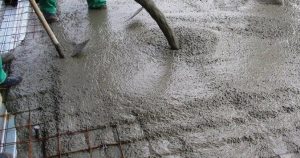As one of the world’s strongest, most durable and versatile construction materials, concrete is used in one form or another in every major construction project from bridges and tunnels to offices and schools.
Builders, engineers, and architects are constantly finding new ways to use concrete. Ready-Mix concrete, for example, is made from a precisely balanced mixture of aggregates, water, and cement from which an incredible variety of cement-based forms can be created.
Over the years concrete has found its way into almost every aspect of modern society from playgrounds to professional sports arenas, residential homes to high-rise buildings, airport runways to mass transit stations, and car parks to high-speed highways.

Concrete Finishes
Concrete can be made to look like expensive building materials such as wood or slate. The finishing skills of a concrete finishing team can turn a drab concrete slab into a work of art. For example, by adding special details, large expanses of concrete can be visually scaled down.
Colour Finishes
By mixing pigments into the concrete it can be produced in a variety of interesting colors that become an integral part of the material.
Colour Cautions
Because colour in a specific mix design may vary slightly from load to load,
we recommend that the following additional steps are taken in the preparation stages:
Consistency
The use of a super-plasticizer is recommended if a higher slump is required.
Special Care
Special care must be taken with the addition of water.
Planning
To minimize color discrepancies it is important to plan exactly where one load will end and another one will begin.
Additives
Only non-chloride accelerators should be used as calcium chloride could dramatically change the colour of concrete.
Curing
As with normal concrete, coloured concrete should be allowed to cure for 3 to 7 days. Temperature, age, the consistency of sub-grades and forms, and the type of concrete at the time of pouring will also affect the colour.
Sealing
Once the concrete has matured to allow the moisture content to be reduced, sealers should be applied to prevent mottling.
Pouring Coloured Concrete …
Patterns and Textures
Special tools can be used to pattern-stamp concrete to make it look like slate, brick, cobblestone, tile, or other types of textured surfaces. Traditional concrete can be given an exposed aggregate finish for a more natural look. An exposed aggregate look can be achieved by washing away surface mortar just before the concrete starts to harden.

